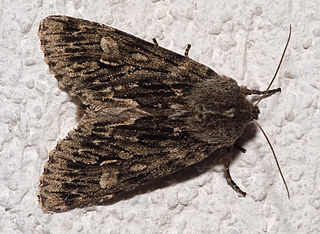Related Research Articles

The herald is a moth of the family Erebidae. The species was first described by Carl Linnaeus in his 1758 10th edition of Systema Naturae. It is found throughout the Palearctic and Nearctic (Holarctic).

Brachionycha nubeculosa, the Rannoch sprawler, is a moth of the family Noctuoidea. It is found across the Palearctic from the British Isles in the west, across central and northern Europe over Russia, Siberia to China. The species is only locally distributed in central Europe, but is often relatively common in this region. In southern Europe, the occurrence is limited to some mountainous regions. In Germany, it reaches as far as the summit regions of the low mountain ranges. The species is moisture loving and prefers moist, cool temperate forests, mixed forests, wooded valleys, river and stream edges as well as orchards.

Panemeria tenebrata, the small yellow underwing, is a moth of the family Noctuidae. The species was first described by Giovanni Antonio Scopoli in his 1763 Entomologia Carniolica. It is found in Europe but is missing in northern Scandinavia, in Portugal, in central and southern Spain, as well as on most Mediterranean islands, except Sicily. In the east, the range extends to the Ural mountains, but the east distribution limits are still insufficiently known. Occurrence in Asia Minor is uncertain, but it is known from Jordan and Israel.

Mesapamea secalis, the common rustic, is a moth of the family Noctuidae. The species was first described by Carl Linnaeus in his 1758 10th edition of Systema Naturae. It is found in Europe, north-west Africa, Turkey and northern Iran.
Nemophora panaeola is a moth of the Adelidae family. It is found in Queensland.
Platyptilia campsiptera is a species of moth in the family Pterophoridae. This species is endemic to New Zealand. This species has been classified as Nationally Vulnerable by the Department of Conservation.

Scirpophaga incertulas, the yellow stem borer or rice yellow stem borer, is a species of moth of the family Crambidae. It was described by Francis Walker in 1863. It is found in Afghanistan, Nepal, north-eastern India, Sri Lanka, Bangladesh, Myanmar, Vietnam, Thailand, Malaysia, Singapore, Sumatra, Java, Borneo, Sumba, Sulawesi, the Philippines, Taiwan, China and Japan.
Brachmia carphodes is a moth in the family Gelechiidae. It was described by Edward Meyrick in 1908. It is found in Assam, India.
Arogalea melitoptila is a moth of the family Gelechiidae. It is found in Brazil.
Canthonistis amphicarpa is a moth in the family Gelechiidae. It was described by Edward Meyrick in 1922. It is found on Java in Indonesia.

Tricyanaula metallica is a moth of the family Gelechiidae. It was described by Walsingham in 1891. It is found in South Africa and Gambia.
Stenoma ancylacma is a species of moth of the family Depressariidae. It is found in Peru.
Timyra lecticaria is a moth in the family Lecithoceridae. It was described by Edward Meyrick in 1916. It is found in Sri Lanka.
Exaeretia hermophila is a moth in the family Depressariidae. It was described by Edward Meyrick in 1922. It is found in Guinea.
Comotechna parmifera is a moth in the family Depressariidae. It was described by Edward Meyrick in 1921. It is found in Peru and Pará, Brazil.
Comotechna scutulata is a moth in the family Depressariidae. It was described by Edward Meyrick in 1921. It is found in Brazil.
Imma melotoma is a moth in the family Immidae. It was described by Edward Meyrick in 1906. It is found in Sikkim, India.
Imma neurota is a moth in the family Immidae. It was described by Edward Meyrick in 1906. It is found on Borneo.
Imma thyriditis is a moth in the family Immidae. It was described by Edward Meyrick in 1906. It is found on the Solomon Islands.
Imma flammula is a moth in the family Immidae. It was described by Alexey Diakonoff in 1978. It is found in Nepal.
References
- ↑ "Canthonistis Meyrick, 1922" at Markku Savela's Lepidoptera and Some Other Life Forms. Retrieved July 12, 2017.
- ↑ Bulletin of the United States National Museum 257: 127
| This article on a moth of the subfamily Gelechiinae is a stub. You can help Wikipedia by expanding it. |